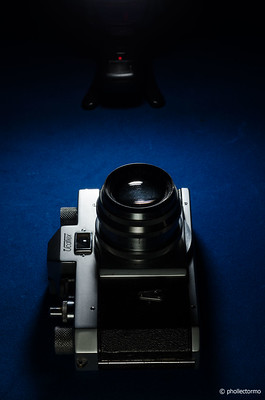ELOP

|
| Ucaflex viewfinder/single-lens-reflex hybrid camera image by phollectormo (Image rights) |
ELOP was a camera maker in Flensburg, north Germany, shortly after the Second World War. According to McKeown, the company was begun as Electro Optic GmbH, in the nearby town of Glücksburg, in 1945, and did not begin making cameras until 1947.[1] In 1948 or '49 the company became ELOP Vereinigte Elektro-Optische Werke GmbH (ELOP United Electro-Optical Works), and moved to Flensburg;[1] this name implies a merger, and notes at Tigin's Classic Cameras state that the merger was with Optische Werkstätten Hans Buschak in Flensburg.[2] 'Tigin' also gives a different name, ELCA Optik for the original Glücksburg company. The company made several models of the Elca, a simple camera for square exposures on 35 mm film. It then began to make a much more sophisticated camera, the Uniflex (later renamed Ucaflex) with reflex focusing.
In 1949 (according to 'Tigin') or '51 (McKeown), the company failed financially (perhaps when investing to produce the Uniflex), but was rescued with state investment, and restarted as UCA Werkstätten für Feinmechanik und Optik GmbH.
The company was bought by Agfa in 1952, and stopped making cameras. 'Tigin' states that some parts were still made for Agfa.[2]
Cameras
- Elca: a simple viewfinder camera for 24 mm-square exposures on 35 mm film, made by the original Electro Optik company. It has a 35 mm f/4.5 Elocar anastigmat lens, a single-speed shutter, and a reverse-Galilean viewfinder. Metal-bodied with black painted finish.
- Elca II: improved model made by ELOP, with a Vario or Prontor-S shutter. 3.5 cm f/4.5 Elocar or 4 cm f/2.5 Elopan lens. Leatherette covering in place of paint, and the camera has a cold shoe.
- Ucanett: third model similar to the Elca, made by Uca. Lenses are now named Ucar and Ucapan.
- Uniflex, later renamed Ucaflex: full-frame 35 mm camera with a focal-plane shutter, designed by Robert Neubert of Jena. The camera has a reflex prism and mirror, giving a magnified view of the centre of the frame in the viewfinder for focusing. Both the mirror and prism flip out of the way when the shutter-release is pressed gently, and the eyepiece then looks onto a Galilean viewfinder for framing before exposure.
Notes
- ↑ 1.0 1.1 McKeown, James M. and Joan C. McKeown's Price Guide to Antique and Classic Cameras, 12th Edition, 2005-2006. USA, Centennial Photo Service, 2004. ISBN 0-931838-40-1 (hardcover). ISBN 0-931838-41-X (softcover). p263-4.
- ↑ 2.0 2.1 Notes on ELOP at Tigin's Classic Cameras (archived)